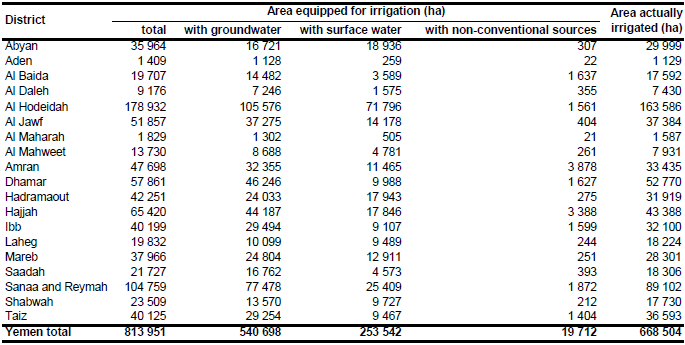AQUASTAT - Sistema mundial de información de la FAO sobre el agua en la agricultura
Yemen
Area equipped for irrigation for year 2004 was estimated at 679 650 ha, consisting of 454 310 ha full/partial control irrigation, 217 541 ha spate irrigation and 7 799 ha equipped lowlands [YE01]. Area actually irrigated shows a high year-to-year variability and mainly depends on the availability of irrigation water. The highest area actually irrigated was reported for year 2007 (732 029 ha). To account for the increasing trend in irrigated land, area equipped for irrigation was estimated for each province as the maximum of area actually irrigated reported for period 2005-2009 [YE02]. Total area equipped for irrigation estimated this way was 813 951 ha as visible in the table below, also downloadable as Yemen irrigation areas in PDF or Yemen irrigation areas in Excel.

The irrigated areas were digitized using Landsat satellite imagery [YE03], MODIS Vegetation Indices [YE04] and several large-scale irrigation maps ([YE05]; [YE06]; [YE07]). The approximate position and extent of the major irrigation schemes was detected based on the large-scale maps, and their more precise extent was derived by digitizing vegetated areas from the satellite imagery. The polygons digitized that way were then combined with cropland extracted from the Globcover regional landcover classification for North Africa [YE08] and irrigated area was first assigned to pixels that were covered by both data layers (digitized polygons AND cropland in Globcover) and after, if required, to pixels covered by just one of the two layers (digitized polygons OR cropland in Globcover). In the provinces of Al-Jawf and Mareb irrigated land was in addition assigned to pixels classified in Globcover as “Sparse vegetation (<15 percent)”.
Area actually irrigated was computed for each province as the mean of the irrigated areas reported for period 2005-2009 [YE02]. The same time series was used to distinguish the source of irrigation water. Areas irrigated from springs and wells were assumed to represent groundwater irrigation, areas irrigated with water from dams, reservoirs and from floods were assumed to represent surface water irrigation and areas irrigated with water from other sources or water obtained by cars was assumed to represent irrigation with non-conventional water sources. Total area actually irrigated computed that way was 668 504 ha (82 percent of area equipped for irrigation). 66.5 percent of the area was irrigated with groundwater, 31.1 percent with surface water and 2.4 percent with water from non-conventional sources.
References
[YE01]: FAO. 2013. AQUASTAT country profile of Yemen, version 2008. FAO, Rome, Italy.
[YE02]: Central Statistics Office. 2006-2010. Statistical yearbook, volumes 2005-2009, section agriculture. http://cso-yemen.org/content.php?lng=english&cid=131, 20/01/2013.
[YE03]: Earth Satellite Corporation. 2004. Landsat GeoCover (2000/ETM+) Edition Mosaics, tiles 071-295, 071-296, 071-307, 071-308 and 071-317. Sioux Falls, USA, USGS, http://glcfapp.umiacs.umd.edu:8080.
[YE04]: NASA, Land Processes Distributed Active Archive Center. 2004. MOD13Q1: MODIS/Terra Vegetation Indices 16-Day L3 Global 250m SIN Grid V004. Enhanced Vegetation Indices (EVI) from 9 June 2000 and 17 January 2001, http://edcimswww.cr.usgs.gov.
[YE05]: Universität Tübingen. 1993. Tübinger Atlas des Vorderen Orients (TAVO), Plate AX1. Reichert, Germany, Wiesbaden.
[YE06]: United States Agency for International Development. 1993. Water Resources Action Plan for the Near East, Figure 3. Washington, DC.
[YE07]: Achtnich, W. 1980. Bewässerungslandbau, p. 39. Stuttgart, Germany, Ulmer.
[YE08]: POSTEL. 2008. GLOBCOVER landcover classification, Version 2.2, North Africa. Globcover database. http://toyo.mediasfrance.org/?GLOBCOVER, 24/03/2009.